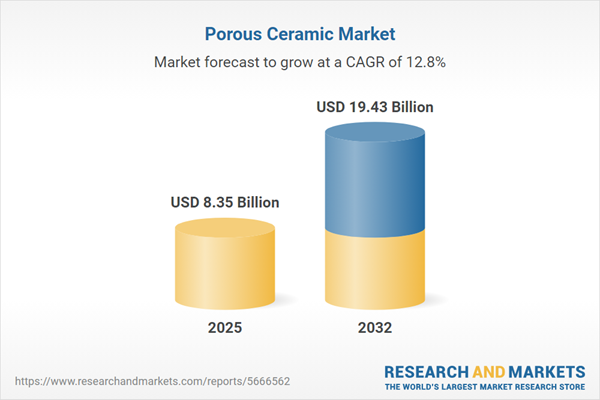Speak directly to the analyst to clarify any post sales queries you may have.
Senior business leaders are increasingly leveraging the porous ceramic market to drive both operational improvement and sustainability across industries. Evolving market dynamics require executives to align procurement and manufacturing strategies with the latest material innovation and regulatory requirements.
Market Snapshot: Porous Ceramic Market Outlook
The global porous ceramic market demonstrates robust growth, currently valued at USD 7.40 billion in 2024, with an anticipated rise to USD 8.35 billion in 2025 and USD 19.43 billion by 2032. This represents a consistent compound annual growth rate (CAGR) of 12.82%.
Growth is primarily supported by the ongoing need for materials that meet new compliance standards, boost manufacturing reliability, and support sustainable production across multiple sectors. Senior procurement professionals are prioritizing porous ceramic technologies to strengthen supply chain resilience and ensure continued business performance. With mounting focus on environmental responsibility, porous ceramics are becoming essential to executive planning and long-term operational strategies.Scope & Segmentation of the Porous Ceramic Market
- Applications: Porous ceramics are leveraged for biomedical devices, catalyst supports, insulation, and diverse filtration systems. These functions provide crucial solutions for precision separation, emissions reduction, and robust equipment performance in sectors including healthcare, automotive, and chemical processing.
- Material Types: The market features oxide ceramics such as alumina, silica, and titania, along with non-oxide variants like silicon carbide and zirconia. These distinct groups address varying industry demands for thermal stability and chemical resistance, enhancing adaptability across complex environments.
- End-User Industries: Companies in automotive, power generation, oil and gas, and chemical processing utilize porous ceramics to improve asset longevity, meet regulatory benchmarks, and achieve efficiency across critical operations.
- Pore Sizes: Options extend from macroporous products, preferred for high flow requirements, to microporous designs suited for sensitive and regulated applications, including advanced medical filtration.
- Processes: Key fabrication processes include 3D printing, sacrificial templating, chemical foaming, and freeze casting, all supporting highly customized, application-specific solutions that address evolving manufacturing needs.
- Regions: Market activity spans the Americas, Asia-Pacific, Europe, Middle East, and Africa, where varying regulatory regimes, industrial priorities, and supplier strategies shape the competitive landscape for procurement leaders.
- Leading Companies: Notable participants such as Morgan Advanced Materials PLC, CoorsTek, CeramTec GmbH, Saint-Gobain S.A., Allied Mineral Products, 3M Company, Kyocera, Porvair PLC, Pall Corporation, and Corning Incorporated bring specialized expertise to their global clients.
Key Takeaways for Senior Decision-Makers
- Adoption of additive manufacturing and digital light processing gives organizations increased design latitude, supporting reliable, high-precision production in demanding sectors.
- Innovative production techniques using bio-based binders help companies align manufacturing with sustainability mandates while supporting environmental goals.
- Collaborative research programs with technology companies and institutions accelerate integration of porous ceramic solutions, particularly for unique needs in healthcare and complex filtration.
- Utilization of digital supply networks enables near real-time visibility, facilitating agile risk management and operational continuity even amid frequent disruptions.
- Advanced informatics and analytics enhance maintenance scheduling and responsiveness, strengthening compliance with evolving regulations and technological standards.
Tariff Impact: Navigating US Trade Policy
Recent shifts in US trade tariffs prompt companies to revisit sourcing strategies, diversify supplier relationships, and assess alternative production sites. These proactive measures increase organizational agility and reduce exposure to trade-related risks, equipping companies to navigate both regulatory and commercial changes effectively.
Methodology & Data Sources
This analysis draws on extensive, structured interviews with senior industry executives, thorough secondary-source evaluations, and comprehensive quantitative modeling. All insights are validated with peer-reviewed materials, providing actionable intelligence for strategic leadership decisions.
Why This Report Matters: Executive Value
- Guides senior management in pinpointing high-impact growth opportunities within the porous ceramic market, directly supporting operational excellence and sustainability priorities.
- Delivers actionable assessment of regulatory trends and market dynamics to enhance procurement decisions and bolster market resilience.
- Provides practical strategic advice for regional market entry and helps leaders navigate intricate sector demands, fueling innovation-driven expansion efforts.
Conclusion: Forward Strategy for the Porous Ceramic Market
Organizations that embrace advanced manufacturing and agile procurement will be positioned to capture new opportunities and sustain competitive advantage as porous ceramic market requirements advance.
Additional Product Information:
- Purchase of this report includes 1 year online access with quarterly updates.
- This report can be updated on request. Please contact our Customer Experience team using the Ask a Question widget on our website.
Table of Contents
3. Executive Summary
4. Market Overview
7. Cumulative Impact of Artificial Intelligence 2025
Companies Mentioned
The companies profiled in this Porous Ceramic market report include:- Morgan Advanced Materials PLC
- CoorsTek, Inc.
- CeramTec GmbH
- Saint-Gobain S.A.
- Allied Mineral Products, Inc.
- 3M Company
- Kyocera Corporation
- Porvair PLC
- Pall Corporation
- Corning Incorporated
Table Information
| Report Attribute | Details |
|---|---|
| No. of Pages | 182 |
| Published | October 2025 |
| Forecast Period | 2025 - 2032 |
| Estimated Market Value ( USD | $ 8.35 Billion |
| Forecasted Market Value ( USD | $ 19.43 Billion |
| Compound Annual Growth Rate | 12.8% |
| Regions Covered | Global |
| No. of Companies Mentioned | 11 |








